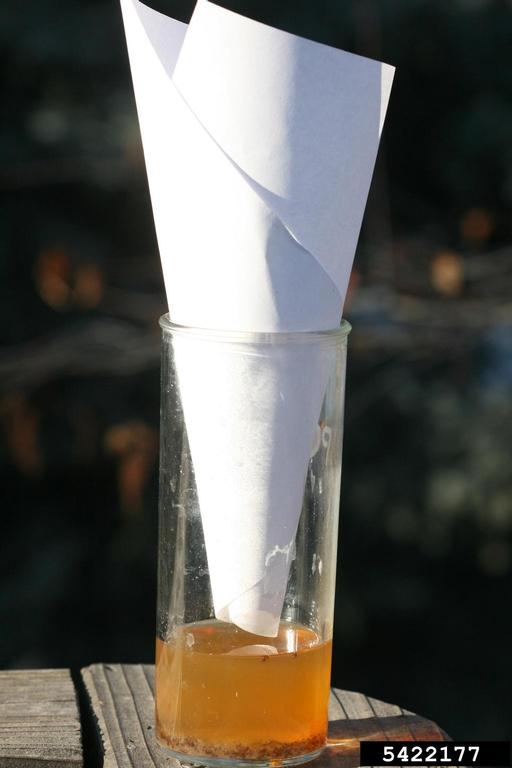How to get rid of fruit flies in your home
Fruit flies can become bothersome indoors. Here are some tips for removing them.

Flies of all kinds peak in numbers during late summer due to the availability of decaying fruit and other organic material outdoors. While fruit flies can be found indoors in the presence of overripe fruits, the fall months are a time when their population size is high and bothersome. This is especially true for anyone with a vegetable garden or backyard orchard.
Fruit flies, also known as vinegar flies (family Drosophilidae), are very small (about 1/10 inch) and light brown with red eyes (Photo 1). They love fermenting fruits and are attracted to sweet liquids including fruit, or vegetable juice, and unwashed soda and beer cans with liquid inside them. Sometimes, the flies can be brought accidentally with produce that has eggs already laid inside.
Fruit flies may be small enough to pass through window screens, making exclusion a challenge if you enjoy keeping your windows open. They are irritating to gardeners who want to display their hard-earned produce on the kitchen table. In particular, ripe tomatoes can become a breeding ground in just a few days. After laying eggs inside overripe or rotting produce, the larvae emerge in a few days and become adults in as little as seven to 10 days. It can seem like fruit flies appear out of nowhere.
Control options
While there are aerosol insecticides labeled for control of adult fruit flies, chemical control alone will not solve the issue. The adults that you see flying around your kitchen may have already laid eggs. Killing them will have a small impact on the future population in your home. Control efforts should be focused on the egg and immature stages of this pest. Eliminating the food sources of immature fruit flies and frequent sanitation to kill the eggs are the best ways to keep fruit fly numbers down. Ripe fruit or damaged fruit should be eaten, refrigerated or thrown away.
Fruit flies can reproduce anywhere there is wet, fermenting organic matter present. Check drawers and other areas where fruit, potatoes or onions are stored to make sure none are starting to rot or leak juice. For severe outbreak of fruit flies, empty the kitchen garbage can every evening and make sure it is clean and dry before adding new garbage. Any spilled fruit juice, beer, wine or liquids that may ferment should be completely cleaned up. Check under your refrigerator and other movable appliances and furniture for hidden spills and messes. Thoroughly clean recyclable cans and bottles before storing them and avoid storing them in the living space whenever possible.
Fruit flies may also develop in garbage disposals and drains. Drains and traps should be cleaned as well as possible and sterilized with boiling water. If unsure whether drains are the source of fruit flies, cover the drain overnight with a plastic food storage bag and inspect the next morning for adult fruit flies.
In combination with the sanitation steps previously outlined, homemade or commercially available fruit fly traps can aid in reducing their numbers. Here are two fruit fly trap designs Michigan State University Extension recommends:
Option 1. Use a small jar with a homemade paper cone set on top with the narrow end of the cone pointing down (Photo 2). Place a bit of juice or rotting fruit in the bottom to attract the flies. The paper cone will keep them in the jar until they die. A variation of this trap is to use a small kitchen funnel set into a tall wine glass with a splash of wine in the bottom of the glass. Empty the trap and replace the juice, fruit or wine every day.

Option 2. Fill several small juice glasses or bowls with apple cider vinegar to about two-thirds full. Add a drop or two, no more, of liquid dishwashing soap to the vinegar and swirl it a bit. Then, stretch plastic wrap across the top of the glass so it is taut. A rubber band will hold it in place. Punch about a dozen or so holes in the plastic wrap with a toothpick and set out the traps where the flies seem to congregate. The flies enter the trap through the holes and drown themselves in the vinegar. Empty and refresh as needed.



 Print
Print Email
Email